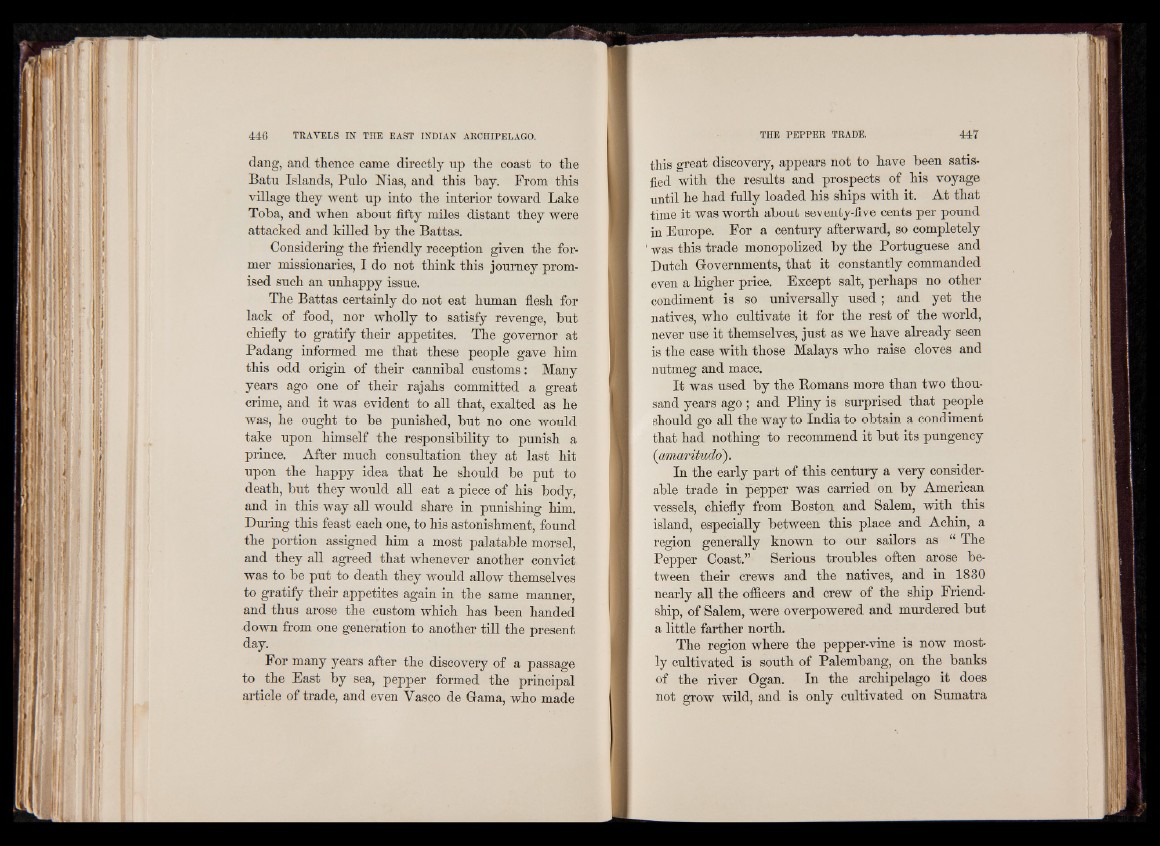
dang, and thence came directly up the coast to the
Batu Islands, Pulo Nias, and this hay. From this
village they went up into the interior toward Lake
Toba, and when about fifty miles distant they were
attacked and killed by the Battas.
Considering the friendly reception given the former
missionaries, I do not think this journey promised
such an unhappy issue.
The Battas certainly do not eat human flesh for
lack of food, nor wholly to satisfy revenge, but
chiefly to gratify their appetites. The governor at
Padang informed me that these people gave him
this odd origin of their cannibal customs: Many
years ago one of their rajahs committed a great
crime, and it was evident to all that, exalted as he
was, he ought to be punished, but no one would
take upon himself the responsibility to punish a
prince. After much consultation they at last hit
upon the happy idea that he should be put to
death, but they would all eat a piece of his body,
and in this way all would share in punishing him,
During this feast each one, to his astonishment, found
the portion assigned him a most palatable morsel,
and they all agreed that whenever another convict
was to be put to death they would allow themselves
to gratify their appetites again in the same manner,
and thus arose the custom which has been handed
down from one generation to another till the present
day.
For many years after the discovery of a passage
to the East by sea, pepper formed the principal
article of trade, and even Vasco de Grama, who made
this great discovery, appears not to have been satisfied
with the results and prospects of his voyage
until he had fully loaded his ships with it. At that
time it was worth about seventy-five cents per pound
in Europe. For a century afterward, so completely
' was this trade monopolized by the Portuguese and
Dutch Gfovernments, that it constantly commanded
even a higher price. Except salt, perhaps no other
condiment is so universally used; and yet the
natives, who cultivate it for the rest of the world,
never use it themselves, just as we have already seen
is the case with those Malays who raise cloves and
nutmeg and mace.
It was used by the Romans more than two thousand
years ago; and Pliny is surprised that people
should go all the way to India to obtain a condiment
that had nothing to recommend it but its pungency
(it/ma/ritudo).
In the early part of this century a very considerable
trade in pepper was carried on by American
vessels, chiefly from Boston and Salem, with this
island, especially between this place and Achin, a
region generally known to our sailors as “ The
Pepper Coast.” Serious troubles often arose between
their crews and the natives, and in 1830
nearly all the officers and crew of the ship Friendship,
of Salem, were overpowered and murdered but
a little farther north.
The region where the pepper-vine is now mostly
cultivated is south of Palembang, on the banks
of the river Ogan. In the archipelago it does
not grow wild, and is only cultivated on Sumatra